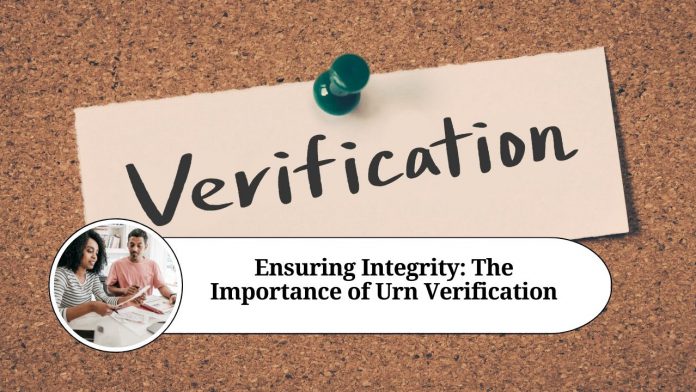Urn verification is a process that involves checking the authenticity and integrity of an urn or a container that holds important documents or materials. The purpose of urn verification is to ensure that the contents of the urn have not been tampered with or altered in any way and that the urn itself is genuine and has not been replaced.
Urn verification is an essential process in a variety of contexts, including legal proceedings, medical research, and scientific experiments. In legal proceedings, urns may be used to hold evidence such as DNA samples or blood samples, which need to be verified to ensure their integrity. In medical research, urns may be used to store biological samples, which also need to be verified to ensure that the results of the research are reliable. In scientific experiments, urns may be used to store samples of chemicals or other substances, which must be verified to ensure that the results of the experiment are accurate.
There are several methods used for urn verification. One of the most common methods is visual inspection, which involves examining the urn for signs of tampering or damage. This may include checking the seal or lock on the urn, looking for scratches or other marks on the surface of the urn, or checking for signs of rust or corrosion. If any of these signs are present, it may indicate that the urn has been tampered with or replaced.
Another method used for urn verification is chemical analysis. This involves testing the contents of the urn to ensure that they are genuine and have not been altered. For example, DNA samples can be tested to ensure that they have not been contaminated or substituted with another sample. Chemical analysis may also be used to test the integrity of the urn itself, such as checking for the presence of any chemical residues that may indicate tampering.
In addition to these methods, there are also specialized technologies that can be used for urn verification. For example, some urns may be equipped with RFID (radio frequency identification) tags, which can be used to track the urn and ensure that it has not been moved or replaced. Other urns may use biometric authentication, such as fingerprint scanning, to ensure that only authorized individuals can access the contents of the urn.
Urn verification is a critical process that helps to ensure the accuracy and reliability of important documents and materials. By using a variety of methods and technologies to verify urns, organizations can ensure that their data is protected and their research results are valid. If you need to use an urn for legal or scientific purposes, it’s important to work with a reputable provider and follow best practices for urn verification to ensure that your data is accurate and trustworthy.
Urn verification is particularly important in situations where the contents of the urn are critical to making important decisions. For example, in legal cases, the results of DNA tests can have a significant impact on the outcome of the trial. If the integrity of the urn that holds the DNA sample is in question, it can cast doubt on the accuracy of the test results and potentially affect the outcome of the trial.
Similarly, in scientific research, the accuracy and reliability of research results depend on the integrity of the materials used in the experiment. If there is any doubt about the authenticity or quality of the materials, the results of the experiment may be called into question, and the research may have to be repeated.
To ensure the accuracy and integrity of urns, various protocols and standards have been developed. For example, the International Organization for Standardization (ISO) has established guidelines for the handling and storage of biological materials, including DNA samples. These guidelines include recommendations for the use of appropriate containers and labels and for the use of appropriate storage and transport conditions.
In addition, many organizations that handle urns have established their own protocols for urn verification. These protocols may include procedures for inspecting the urn for signs of tampering, testing the contents of the urn using chemical or biological methods, and using specialized technologies such as RFID tags or biometric authentication.
One challenge in urn verification is ensuring that the verification process does not itself introduce errors or alter the contents of the urn. For example, if the contents of an urn are tested using chemical analysis, there is a risk that the testing process could alter the chemical composition of the sample. To mitigate this risk, the testing process must be carefully designed and executed, using appropriate controls and validation procedures.
Another challenge in urn verification is ensuring that the verification process is consistent and reliable. This may require regular calibration and testing of equipment, as well as the use of trained personnel who are familiar with the relevant protocols and standards.
In conclusion
Urn verification is a critical process that helps to ensure the accuracy and integrity of important documents and materials. By using appropriate protocols, standards, and technologies, organizations can ensure that their urns are secure and reliable and that the contents of the urns are protected from tampering or alteration.
Read more useful content:
- section 145 of income tax act
- section 10e of income tax act
- section 9 of the income tax act
- section 94b of income tax act
- section 206aa of income tax act
Frequently Asked Questions (FAQs)
Q1. What is urn verification?
Urn verification is the process of checking the authenticity and integrity of an urn or container that holds important documents or materials.
Q2. Why is urn verification important?
Urn verification is important to ensure that the contents of the urn have not been tampered with or altered in any way and that the urn itself is genuine and has not been replaced. It is critical in legal cases, medical research, and scientific experiments where the accuracy and reliability of the results depend on the integrity of the materials used.
Q3. What methods are used for urn verification?
Methods used for urn verification include visual inspection, chemical analysis, and specialized technologies such as RFID tags and biometric authentication.
Q4. How does visual inspection work?
Visual inspection involves examining the urn for signs of tampering or damage, such as checking the seal or lock on the urn, looking for scratches or other marks on the surface of the urn, or checking for signs of rust or corrosion.
Q5. How does chemical analysis work?
Chemical analysis involves testing the contents of the urn to ensure that they are genuine and have not been altered. For example, DNA samples can be tested to ensure that they have not been contaminated or substituted with another sample.
Q6. What specialized technologies are used for urn verification?
Specialized technologies used for urn verification include RFID tags, which can be used to track the urn and ensure that it has not been moved or replaced, and biometric authentication, such as fingerprint scanning, to ensure that only authorized individuals can access the contents of the urn.
Q7. What standards and protocols exist for urn verification?
The International Organization for Standardization (ISO) has established guidelines for the handling and storage of biological materials, including DNA samples. Many organizations that handle urns have established their own protocols for urn verification, which may include procedures for inspecting the urn, testing the contents, and using specialized technologies.
Q8. How can organizations ensure that the urn verification process is consistent and reliable?
Organizations can ensure that the urn verification process is consistent and reliable by regularly calibrating and testing equipment, using trained personnel who are familiar with the relevant protocols and standards, and using appropriate controls and validation procedures to mitigate the risk of introducing errors or altering the contents of the urn.




















